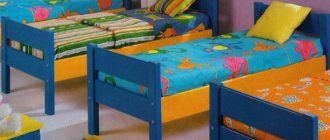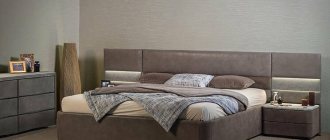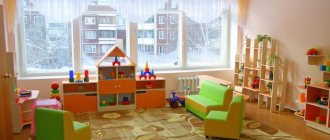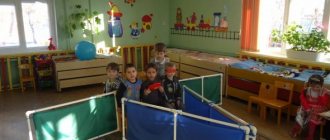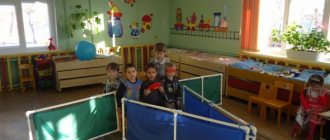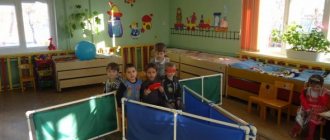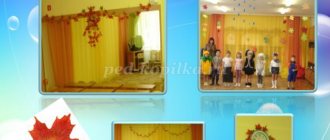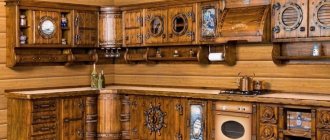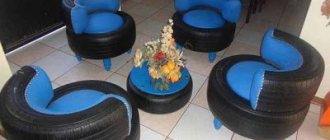There are over 45 thousand preschool institutions in our country, and in each of them you can see a wide variety of furniture that creates a beautiful and cheerful interior for kindergartens. What requirements and standards should manufacturers comply with? What SanPiN and Federal State Standards markings are present on the products? How is specialized furniture for kindergartens manufactured?
What furniture is needed to set up a kindergarten?
Furniture for preschoolers:
- for storage (closets for clothes, chests of drawers for small items and toys, shelves for books and crafts);
- desks (for classes of older groups);
- beds;
- chairs;
- game and dining tables;
- playroom (for example, a toy kitchen, shop or train);
- clothes hangers.
Each kindergarten has a gym, which also requires furnishings. Furniture for a sports room includes benches and corners for storing equipment. All groups of furniture for preschoolers must be of high quality.
So what is a furniture height group?
The very concept of “growth group” arose from considerations of the healthy development of the child’s body. To develop correct healthy posture in children, it is necessary that they not only lead an active lifestyle, but also sit correctly at their desks on the right chairs. For this purpose, height groups were developed, in which the height of the chair and table depend directly on the height of the child, and take into account the peculiarities of the child’s seating position.
Important! When selecting furniture, you need to consider that:
- with your knees bent 90 degrees, your feet should be in full contact with the floor;
- there must be a space of at least 110 mm between the knees and the tabletop for free movement,
- the front edge of the chair should not be closely adjacent to the popliteal hollows, the lower part of the thigh should be free from the pressure of the chair,
- the forearm of the hand, bent at the elbow 90 degrees, should lie calmly without tension on the tabletop,
- the back of the chair should provide back support in two places (lumbar region, lower part of the shoulder blades),
- There should be free space between the chair seat and the backrest.
All of the above conditions are met in growth groups. And knowing the height of your child, you no longer have to run around all the stores with a tape measure and try on furniture. It’s enough to just decide on this same growth group.
Requirements for furniture for kindergartens
Now let's move on to the furniture requirements. All manufacturers of furniture for kindergartens must create products:
- Safe. Such products should not harm the child or cause allergies.
- Durable. If a child, for example, rocks on a chair, the legs of the product should not break or bend.
- Convenient and practical.
- Eco-friendly. Such products should be made from natural materials.
- Easy. Furniture items should be easy for a child to move.
- Beautiful and cheerful. Such products should appeal to children and attract their attention.
- Without sharp corners, withstands exposure to water and detergents.
Reminder of key points
- Choose the material . The price depends on it.
- Study the quality of the materials used. It must be confirmed by relevant certificates. The health of children depends on it.
- Choose the type of construction . Consider your own preferences.
- Check the reliability of the manufacturer . See experience in this field, documents and product certificates.
- Check the warranty from the manufacturer. This is an indicator of the supplier's confidence in its own products.
Manufacturing of children's furniture
The production of modern furniture for a kindergarten is similar to the production of conventional furnishings. However, here you need to be more careful in choosing materials. You also need to comply with more SanPiN and Federal State Educational Standards standards. Basically, kindergarten furniture is made from wood. Now let's take a closer look at the production process specifically. First of all, a drawing and 3D model of the future item is created. Then the choice of raw materials occurs, either natural wood or high-quality plywood is selected. The selected tree should be hypoallergenic and lightweight so that the child can easily move the furniture. The boards are then placed in a drying chamber for 10-12 days, and after drying, they are freed from bark and divided into blanks. Next, products are manufactured from these blanks and covered with the most hypoallergenic and environmentally friendly paint.
A special place in the production of furniture for kindergartens is occupied by the design of lockers for things. This is done directly by the teacher. The locker room, where the lockers for clothes and things are actually located, is the “face” of the group. Therefore, the design of lockers in kindergarten is so important for the kindergarten. On each locker there is always the child's first and last name, as well as a funny picture, individual for each locker.
Design themes
Kindergarten cabinets are often made unpainted or with color evenly distributed across all doors. This is done so that children do not quarrel over the color of the locker or its design. But the wardrobe must belong to one child, which means it must be marked. This is done by marking the doors. Markings on cabinets are applied using paint or stickers. It comes in various types:
- color;
- animals;
- pictures;
- in numbers.
It is not advisable to use inscriptions as markings on the cabinet, since not all children can read at kindergarten age. If the group is senior or preparatory, you can put numbers on the doors. But before that, you need to make sure that all children know them and will not get confused.
To make wardrobes more beautiful for children, it is advisable to use pictures as labels. Each child remembers which symbol corresponds to his door. Inside the locker room, in a place visible to parents, there is a sign indicating the symbol of each child. These can be the simplest geometric shapes - stars, triangles, squares, and so on, if the group is middle-aged. For kids, it is preferable to use images of animals as tags. This way, the child will always be able to find his own wardrobe and distinguish it from others.
Stickers with your favorite fairy tale or cartoon characters are suitable for colorful decoration. Each child can independently choose with their parents the image of the sign on the locker. It must be remembered that the design of furniture should correspond to the age of the children.
How to mark chairs and tables in kindergarten according to SanPiN
Below is the marking of chairs and tables in kindergarten:
Group in kindergarten Child's height, cm Table height, cm Chair height, cm Color of new SanPiN furniture marking in kindergarten 00 to 85 34 18 Black 0 85-100 40 22 White 1 101-115 46 26 Orange 2 116-130 52 30 Purple 3 over 130 58 34 Yellow
According to the Federal State Educational Standard, children's furniture for preschool educational institutions must first of all be safe. Also made from high quality, natural materials. Its convenience and durability are highly valued. According to the Federal State Educational Standard, furniture in a kindergarten must have the above markings.
Size according to SanPiNmaterial on the topic
Dimensions according to SanPiN
View full text SanPiN 2.4.1.3049-13 Sanitary and epidemiological requirements for the design, content and organization of work in preschool organizations. The current SanPiN 2.4.1.3049-13 was adopted on May 15, 2013, and came into force on July 30, 2013, replacing the expired SanPiN 2.4.1.2660-10. Excerpt from SanPiN 2.4.1.3049-13:
6.5. In group rooms for children 1.5 years and older, tables and chairs must be selected according to the height group of the children. For children in the senior and preparatory groups, it is recommended to use tables with a variable tilt of the lid up to 30 degrees.
6.6. Chairs and tables must be from the same furniture group and labeled. The selection of furniture for children is carried out taking into account the growth of children according to Table 1.
Table 1. Main sizes of tables and chairs for young children and preschool age
| Children's height group (mm) | Furniture group | Table height (mm) | Chair seat height (mm) |
| up to 850 | 340 | 180 | |
| over 850 to 1000 | 0 | 400 | 220 |
| from 1000 - 1150 | 1 | 460 | 260 |
| from 1150 - 1300 | 2 | 520 | 300 |
| from 1300 - 1450 | 3 | 580 | 340 |
| from 1450 - 1600 | 4 | 640 | 380 |
6.7. Working surfaces of tables should have a light-colored matte finish. Materials used for lining tables and chairs must have low thermal conductivity and be resistant to moisture, detergents and disinfectants.
6.8. Chalk boards must be made of materials that have high adhesion to materials used for writing, can be easily cleaned with a damp sponge, be wear-resistant, have a dark green or brown color and an anti-reflective or matte finish.
6.9. When using a marker board, the color of the marker should be contrasting (black, red, brown, dark tones of blue and green). Blackboards that do not have their own glow should be provided with uniform artificial lighting.
6.10. Preschool educational organizations use toys that are harmless to the health of children, meet sanitary and epidemiological requirements and have documents confirming safety, which can be subjected to wet processing (washing) and disinfection. Soft-fill and foam latex brushed toys for preschool children should be used only as teaching aids.
6.11. Placing aquariums, animals, and birds in group rooms is not permitted.
6.12. In newly built preschool educational organizations, group ones should have separate sleeping quarters. Bedrooms are equipped with fixed beds. When designing a group room, it is allowed to provide for the presence of a sliding (transformable) partition to allocate sleeping places (bedrooms), which are equipped with folding beds with a hard bed or on transformable (pull-out, roll-out) one-three-level beds.
6.13. In existing preschool educational organizations, if there are no bedrooms according to the project or there is insufficient area of available sleeping quarters, it is allowed to organize daytime sleep for children of preschool groups in groups on folding beds with a hard bed or on transformable (pull-out, roll-out) one- or three-level beds. When using folding beds, each group bed must have space for storing them, as well as for individual storage of bedding and linen. Beds must be appropriate for the height of children. The arrangement of beds should ensure free passage of children between beds, beds and external walls, beds and heating devices.
Where to order furniture for kindergartens
The interior is a specific matter, since furniture for children is significantly different from that for adults. After consulting with the manager, you can easily decide on materials, design, and equipment. As for furniture stores for kindergartens, you can find a large number of them on the Internet with a large assortment and reasonable prices.
When choosing furniture, it is recommended to follow the following tips:
- Be sure to make sure the fastenings and assembly are secure.
- Smell the product; there should be no strong odor or plastic smell.
- Specify the maximum permissible load and age category for which this furniture is designed.
- For children under three years of age, it is not recommended to buy very bright products.
- Furniture should be in accordance with the height and age of children; there is no need to buy it for growth.
- For children 3-5 years old, the furniture should contain a non-aggressive design, for example, Khokhloma painting, and for 6-7 year old children, a more adult design is suitable, for example, images on the theme of a steamship or a spaceship.
- Mattresses and pillows for cribs should be purchased orthopedic in order to form correct posture and ensure a comfortable sleep.
- Products must be resistant to mechanical damage.
Online stores of unusual furniture for kindergartens, made from natural and high-quality materials, offer their clients services for developing design projects based on individual preferences.
So, today we talked about furniture for preschool institutions, what standards and requirements it must meet. Now you know how, where and what kind of furniture for preschool institutions you should choose.
Size matters
Unlike high chairs, which are divided into height groups, according to GOST, cribs are divided into age groups: up to 3 years and from 3 to 7 years.
| Age group | Dimensions, cm | |
| Length | 120 |
| Width | 60 | |
| Height of the bed from the floor | 30 – 50 (adjustable) | |
| Length | 140 |
| Width | 60 | |
| Height of the bed from the floor | 30 | |
Note. For the first age group, it is mandatory to have sides on one or both sides, 95 cm high from the floor.
